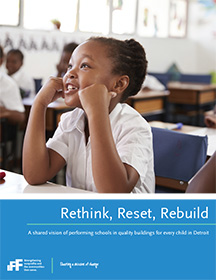 Reset, Rethink, Rebuild: A Shared Vision of Performing Schools in Quality Buildings for Every Child in Detroit is a study about neighborhoods, educational opportunity, and the conditions of public school buildings.
Reset, Rethink, Rebuild: A Shared Vision of Performing Schools in Quality Buildings for Every Child in Detroit is a study about neighborhoods, educational opportunity, and the conditions of public school buildings.
Through a place-based supply-and-demand needs assessment, the report gauges access to performing schools across Detroit and identifies the neighborhoods in which the K-12 education system fails to reach the greatest numbers of children.
To inform comprehensive school improvement and community development, the study also evaluates facilities conditions in and around the highest-need neighborhoods.
The report and accompanying online tool lay the groundwork for cross-sector, citywide collaboration to boost access to performing public schools in the Motor City; to strategically allocate resources, including facilities; and to seize opportunities to adaptively reuse the sites of former schools to strengthen neighborhoods.
DOWNLOAD THE PDF | Highlights | Recommendations | Online Tool
Press questions may be directed to Jose Cerda III at 312 596 5124. Here is our press release.
For a collection of earlier IFF education studies, please visit our research section.
Highlights
- During the 2015-2016 school year, only 19 percent of Detroit’s K-12 students attending traditional district or charter schools within the city limits could access a performing school (one rated “Green” or “Lime” by the Michigan Department of Education). The study estimates that 70,000 of Detroit’s 85,000 public school students — or 4 out of 5 — did not have access to a performing school.
- 38 percent of the need for performing schools was concentrated in 10 of Detroit’s 54 neighborhood areas. More than 30,000 students live in these communities, yet only eight performing district or charter schools were located in them. These 10 highest-need neighborhoods were clustered away from downtown on the city’s East, West, and Southwest sides, and included: (1) Cerveny/Grandmont;(2) Chadsey; (3) Finney; (4) Vernor/Junction; (5) Evergreen; (6) Harmony Village; (7) MacKenzie;(8) Greenfield; (9) Brooks; and (10) Mt. Olivet.
- Beating the odds were 25 schools that provided more than 13,000 seats in performing schools that served mostly high-poverty student populations.
- After evaluating the conditions of facilities in and around the highest-need neighborhoods, there seemed to be little connection between building conditions and school performance, with the highest-performing schools often not located in the highest-quality buildings.
Recommendations
- Root school improvement in place-based strategy. School improvement and rightsizing strategies should be based on the demand for and supply of performing schools and conditions of school buildings in each neighborhood. They should prioritize and include specific strategies for the 10 highest-need neighborhoods, and include ongoing community engagement and transparent decision making to translate unutilized buildings into neighborhood assets.
- Coordinate strategic planning for K-12 public education in Detroit within and across school governing bodies. Identify areas that save costs or provide other mutual benefits, such as by coordinating on school location and sharing best practices and data.
- Base school improvement on transparent, meaningful, and consistent performance indicators. Improve Michigan’s school accountability system, including by developing a rigorous rating that allows for schools to be compared across systems and over time.
- Efficiently allocate facilities resources so that real estate portfolios are commensurate with student enrollment. Secure public and/or philanthropic funding to conduct a detailed review of all district and charter school facilities, and develop estimates for properly restoring and maintaining all facilities. Consider appropriate enrollment, expansion, and co-location strategies that both increase access to performing schools and make better use of underutilized buildings.
Online Tool
To help implement these recommendations and encourage increased collaboration, Rethink, Reset, Rebuild is accompanied by an online tool that allows local stakeholders to visualize demographic, academic performance, and facilities condition data along with the results of the needs assessment at the citywide and neighborhood levels. Click here to see the full online tool in a new window.
Additional Data Tools
Our friends at Data Driven Detroit (D3) have created an online tool to host IFF’s ongoing needs assessment for early childhood education.